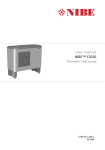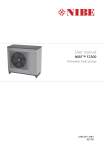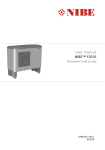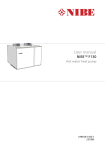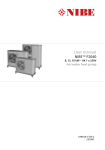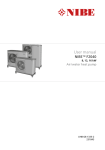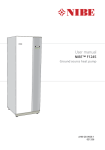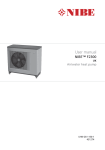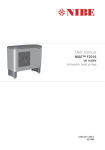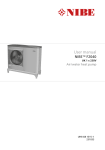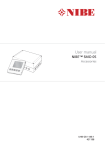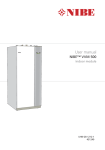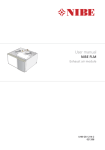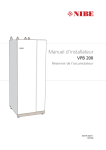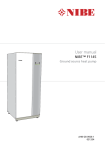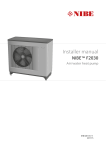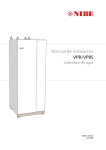Download User manual
Transcript
User manual NIBE™ F2030 LEK Air/water heat pump UHB GB 1317-1 231116 Table of Contents 1 Important information Installation data Safety information Safety precautions Serial number Contact information F2030 - An excellent choice 2 The heat pump – the heart of the house Heat pump function Contact with F2030 Maintenance of F2030 3 Disturbances in comfort Troubleshooting 4 Technical data 5 Glossary Item register Table of Contents | 2 2 4 5 7 8 10 11 11 13 14 19 19 22 23 28 NIBE™ F2030 1 1 Important information Installation data Product F2030 Serial number Installation date Installer Serial number must always be given Certification that the installation is carried out according to instructions in NIBE's installer manual and applicable regulations. Date 2 __________________ Signed _________________________ Channel Name Default Set settings A1 Communications address 1 A3 Connection diff. return temp. 4 °C A4 Start interval compressor 20 min A5 Balance temperature 0 °C A6 Time delay addition relay 120min A7 Stop temperature -20 °C Chapter 1 | Important information ✔ Accessories NIBE™ F2030 Channel Name A8 Min. interval between 65 defrosting A9 Start defrosting -3 °C A10 Stop defrosting +20 °C A14 Activation collar heat- 0 er A15 Activation de-icing fan 0 A16 Defrosting type Chapter 1 | Important information Default Set settings ✔ Accessories 1 NIBE™ F2030 3 Safety information This appliance is designed for use in a home environment and not intended to be used by persons (including children) with reduced physical, sensory or mental capabilities, or lack of experience and knowledge, unless they have been given supervision or instruction concerning use of the appliance by a person responsible for their safety. This in accordance to applicable parts of the low-voltage directive 2006/95/EC, LVD. The appliance is also intended for use by experts or trained users in shops, hotels, light industry, on farms and in similar environments. This in accordance to applicable parts of the machinery directive 2006/42/EC. Children should be supervised to ensure that they do not play with the appliance. This is an original instruction manual. Translation is not allowed without approval from NIBE. Rights to make any design or technical modifications are reserved. ©NIBE 2013. Symbols NOTE This symbol indicates danger to machine or person. Caution This symbol indicates important information about what you should observe when maintaining your installation. TIP This symbol indicates tips on how to facilitate using the product. 4 Chapter 1 | Important information NIBE™ F2030 Marking The CE marking means that NIBE ensures that the product meets all regulations that are placed on it based on relevant EU directives. The CE mark is obligatory for most products sold in the EU, regardless where they are made. Safety precautions Caution The installation must be carried out by a qualified installer. If you install the system yourself, serious problems may occur, for example water leaks, refrigerant leaks, electric shocks, fire and personal injury, as a result of a system malfunction. Use original accessories and the stated components for the installation. If parts other than those stated by us are used, water leaks, electric shocks, fire and personal injury may occur as the unit may not work properly. Install the unit in a location with good support. Unsuitable installation locations can cause the unit to fall and cause material damage and personal injury. Installation without sufficient support can also cause vibrations and noise. Ensure that the unit is stable when installed, so that it can withstand earthquakes and strong winds. Unsuitable installation locations can cause the unit to fall and cause material damage and personal injury. The electrical installation must be carried out by a qualified electrician and the system must be connected as a separate circuit. Power supply with insufficient capacity and incorrect function can cause electric shocks and fire. Do not perform any repairs yourself. Consult the dealer if the system requires repair. Incorrectly performed repairs can cause water leakage, refrigerant leakage, electric shocks or fire. Consult the dealer or an expert regarding removal of the heat pump. Incorrect installation can cause water leakage, refrigerant leaks, electric shocks or fire. Switch off the power supply in the event of a service or inspection. If the power supply is not shut off, there is a risk of electric shocks and damage due to the rotating fan. Do not run the unit with removed panels or protection. Touching rotating equipment, hot surfaces or high voltage parts can cause personal injury due to entrapment, burns or electric shocks. Cut the power before starting electrical work. Failure to cut the power can cause electric shocks, damage and incorrect function of the equipment. Care Do not use the unit where water splashes may occur, for example in laundries. The indoor section is not waterproof and electric shocks and fire can therefore occur. Chapter 1 | Important information NIBE™ F2030 5 Do not use the unit for specialist purposes such as for storing food, cooling precision instruments, freeze-conservation of animals, plants or art. This can damage the items. Do not install the outdoor unit in the locations stated below. - Locations where leakage of combustible gas can occur. - Locations where carbon fibre, metal powder or other powder that can enter the air. - Locations where substances that can affect the unit, for example, sulphide gas, chlorine, acid or alkaline substances can occur. - Locations with direct exposure to oil mist or steam. - Vehicles and ships. - Locations where machines that generate high frequency harmonics are used. - Locations where cosmetic or special sprays are often used. - Locations that can be subjected to direct salty atmospheres. In this case, the outdoor unit must be protected against direct intakes of salty air. - Locations where large amounts of snow occur. - Locations where the system is exposed to chimney smoke. If the bottom frame of the outdoor section is corroded, or in any other way damaged, due to long periods of operation, it must not be used. Using an old and damaged frame can cause the unit to fall and cause personal injury. Do not allow the drainage pipe to exit into channels where poisonous gases, containing sulphides for example, can occur. If the pipe exits into such a channel, any poisonous gases will flow into the room and seriously affect the user's health and safety. Insulate the unit's connection pipes so that the ambient air moisture does not condense on them. Insufficient insulation can cause condensation, which can lead to moisture damage on the roof, floor, furniture and valuable personal property. Do not install the outdoor unit in a location where insects and small animals can inhabit. Insects and small animals can enter the electronic parts and cause damage and fire. Instruct the user to keep the surrounding equipment clean. Dispose of any packaging material correctly. Any remaining packaging material can cause personal injury as it may contain nails and wood. Do not touch any buttons with wet hands. This can cause electric shocks. Do not shut off the power supply immediately after operation has start. Wait at least 5 minutes, otherwise there is a risk of water leakage or breakdown. Do not control the system with the main switch. This can cause fire or water leakage. In addition, the fan can start unexpectedly, which can cause personal injury. 6 Chapter 1 | Important information NIBE™ F2030 Serial number The serial number can be found at the top left of the rear cover and on the foot of the product. 6HULDO QXPEHU Caution Always give the product's serial number when reporting a fault. Chapter 1 | Important information NIBE™ F2030 7 Contact information AT KNV Energietechnik GmbH, Gahberggasse 11, 4861 Schörfling Tel: +43 (0)7662 8963-0 Fax: +43 (0)7662 8963-44 E-mail: [email protected] www.knv.at CH NIBE Wärmetechnik AG, Winterthurerstrasse 710, CH-8247 Flurlingen Tel: (52) 647 00 30 Fax: (52) 647 00 31 E-mail: [email protected] www.nibe.ch CZ Druzstevni zavody Drazice s.r.o, Drazice 69, CZ - 294 71 Benatky nad Jizerou Tel: +420 326 373 801 Fax: +420 326 373 803 E-mail: [email protected] www.nibe.cz DE NIBE Systemtechnik GmbH, Am Reiherpfahl 3, 29223 Celle Tel: 05141/7546-0 Fax: 05141/7546-99 E-mail: [email protected] www.nibe.de DK Vølund Varmeteknik A/S, Member of the Nibe Group, Brogårdsvej 7, 6920 Videbæk Tel: 97 17 20 33 Fax: 97 17 29 33 E-mail: [email protected] www.volundvt.dk FI NIBE Energy Systems OY, Juurakkotie 3, 01510 Vantaa Puh: 09-274 697 0 Fax: 09-274 697 40 E-mail: [email protected] www.nibe.fi FR AIT France, 10 rue des Moines, 67000 Haguenau Tel : 03 88 06 24 10 Fax : 03 88 06 90 15 E-mail: [email protected] www.nibe.fr GB NIBE Energy Systems Ltd, 3C Broom Business Park, Bridge Way, Chesterfield S41 9QG Tel: 0845 095 1200 Fax: 0845 095 1201 E-mail: [email protected] www.nibe.co.uk NL NIBE Energietechniek B.V., Postbus 2, NL-4797 ZG WILLEMSTAD (NB) Tel: 0168 477722 Fax: 0168 476998 E-mail: [email protected] www.nibenl.nl NO ABK AS, Brobekkveien 80, 0582 Oslo, Postadresse: Postboks 64 Vollebekk, 0516 Oslo Tel. sentralbord: +47 23 17 05 20 E-mail: [email protected] www.nibeenergysystems.no PL NIBE-BIAWAR Sp. z o. o. Aleja Jana Pawła II 57, 15-703 BIAŁYSTOK Tel: 085 662 84 90 Fax: 085 662 84 14 E-mail: [email protected] www.biawar.com.pl RU © "EVAN" 17, per. Boynovskiy, Nizhny Novgorod Tel./fax +7 831 419 57 06 E-mail: [email protected] www.nibe-evan.ru 8 Chapter 1 | Important information NIBE™ F2030 SE NIBE AB Sweden, Box 14, Hannabadsvägen 5, SE-285 21 Markaryd Tel: +46-(0)433-73 000 Fax: +46-(0)433-73 190 E-mail: [email protected] www.nibe.se For countries not mention in this list, please contact Nibe Sweden or check www.nibe.eu for more information. Chapter 1 | Important information NIBE™ F2030 9 F2030 - An excellent choice F2030 is an air/water heat pump specially developed for the Nordic climate, which utilises the outside air so there is no need for bore holes or coils in the ground. The heat pump is intended for connection to water borne heating systems and can both heat hot water effectively at high outdoor temperatures and give a high output to the heating system at low outdoor temperatures. If the outdoor temperature drops to a level below the stop temperature all heating must then occur with external additional heat. Excellent properties for F2030: ႑ Efficient scroll compressor New efficient scroll compressor that operates at temperatures down to -25°C. ႑ Intelligent control Integrated intelligent control for optimum control of the heat pump. At a start signal from an NIBE indoor module or thermostat F2030 is started. ႑ Fan F2030 has an automatic 2-step capacity regulator for the fan. ႑ Long service life The material has been chosen for a long service life and is designed to withstand the Nordic outdoor conditions. ႑ Many possibilities F2030 can also be used together with most electric boilers, oil boilers or similar. ႑ Quiet F2030 has a very low noise level. ႑ Draining F2030 has been prepared to lead off the condensation water. 10 Chapter 1 | Important information NIBE™ F2030 2 The heat pump – the heart of the house Heat pump function H +HDWLQJ PHGLXP 5HIULJHUDQW I %ULQH 45 °C 55 °C G E 80 °C &RQGHQVHU Kondensor Expansionsventil ([SDQVLRQ YDOYH F 0 °C Kompressor &RPSUHVVRU Förångare (YDSRUDWRU D 5 °C C B -3 °C +HDW VRXUFH A 2 °C The temperatures are only examples and may vary between different installations and time of year. Chapter 2 | The heat pump – the heart of the house NIBE™ F2030 11 An air/water heat pump can use the outdoor air to heat a property. The conversion of the outdoor air's energy to property heating occurs in three different circuits. In the brine circuit, (1) , free heat energy is retrieved from the surroundings and transported to the heat pump. In the refrigerant circuit, (2) , the heat pump increases the retrieved heat's low temperature to a high temperature. In the heating medium circuit, (3) , the heat is distributed around the house. A B C D E F G H Outdoor air The outdoor air is sucked into the heat pump. The fan then routes the air to the heat pump’s evaporator. Here, the air releases the heating energy to the refrigerant and the air's temperature drops. The cold air is then blown out of the heat pump. Refrigerant circuit A gas circulates in a closed system in the heat pump, a refrigerant, which also passes the evaporator. The refrigerant has a very low boiling point. In the evaporator the refrigerant receives the heat energy from the outdoor air and starts to boil. The gas that is produced during boiling is routed into an electrically powered compressor. When the gas is compressed, the pressure increases and the gas's temperature increases considerably, from 5 °C to approx. 80°C. From the compressor, gas is forced into a heat exchanger, condenser, where it releases heat energy to the heating system in the house, whereupon the gas is cooled and condenses to a liquid form again. As the pressure is still high, the refrigerant can pass an expansion valve, where the pressure drops so that the refrigerant returns to its original temperature. The refrigerant has now completed a full cycle. It is routed to the evaporator again and the process is repeated. Heat medium circuit The heat energy that the refrigerant produces in the condenser is retrieved by the climate system's water, heating medium, which is heated to 55 °C (supply temperature). The heating medium circulates in a closed system and transports the heated water's heating energy to the house water heater and radiators/heating coils. The temperatures are only examples and may vary between different installations and time of year. 12 Chapter 2 | The heat pump – the heart of the house NIBE™ F2030 Contact with F2030 F2030 has an integrated control system that checks and monitors the heat pump operation. At installation the installer makes the necessary settings of the control system so that the heat pump will work optimally in your system. The heat pump is controlled in different ways depending on what your system looks like. If you have a NIBE indoor module heat pump operation can be controlled from there. Refer to the relevant manual for further information. Chapter 2 | The heat pump – the heart of the house NIBE™ F2030 13 Maintenance of F2030 Regular checks When your heat pump is located outdoors some external maintenance is required. NOTE Insufficient oversight can cause serious damage to F2030 which is not covered by the guarantee. Checking grilles Check that the inlet grille is not clogged by leaves, snow or anything else regularly throughout the year. Pay extra attention in event of high winds or snowfall that may cause the grille to be blocked. LEK/APH Prevent snow building up and covering the grille on F2030. 14 Chapter 2 | The heat pump – the heart of the house NIBE™ F2030 LEK/APH Keep free of snow and/or ice. Cleaning the outer casing If necessary the outer casing can be cleaned using a damp cloth. Care must be exercised so that the heat pump is not scratched when cleaning. Avoid spraying water into the grilles or the sides so that water penetrates into F2030. Prevent F2030 coming into contact with alkaline cleaning agents. Condensation drain pan and condensation water pipe The trough and drain pipe may require cleaning from leaves or similar during the year. Cleaning 1. Use the safety switch to cut the incoming electrical supply. 2. Release the trough using the quick release catches on the left and right front edges. Keep in position at the rear edge without stretching the power cable. 3. Clean drain pans and condensation water pipe/drains. 4. Reinstall the trough using the removal method in reverse order (see point 2). 5. Switch on the safety switch again. In event of long power cuts In the event of prolonged power failures it is recommended that the part of the heating system located outdoors is drained. Your installer has installed a shut off and drain valve to facilitate this. Call and ask your installer if you are unsure. Chapter 2 | The heat pump – the heart of the house NIBE™ F2030 15 Saving tips Your heat pump installation produces heat and/or hot water. This occurs via the control settings you made. Factors that affect the energy consumption are, for example, indoor temperature, hot water consumption, the insulation level of the house and whether the house has many large window surfaces. The position of the house, e.g. wind exposure is also an affecting factor. Also remember: ႑ Open the thermostat valves completely (except those thermostats in the rooms that are to be kept cooler for various reasons, e.g. bedrooms). The thermostats slow the flow in the heating system, which the heat pump wants to compensate with increased temperatures. It then works harder and consumes more electrical energy. ႑ Reduce or adjust the settings for heating in any external control systems. Power consumption RI DQQXDO FRQVXPSWLRQ 7KH DLUZDWHU KHDW SXPS V HQHUJ\ GLVWULEXWLRQ VSUHDG DFURVV WKH \HDU 25% 20% 15% 10% 5% 0% -DQ jan )HE feb 0DU mars $SULO april 0D\ maj -XQH juni -XO\ juli $XJ aug 6HS sep 2FW okt 1RY nov 'HF dec 0RQWK Increasing the indoor temperature one degree increases power consumption by approx. 5%. Domestic electricity In the past it has been calculated that an average Swedish household has an approximate annual consumption of 5000 kWh domestic electricity/year. In today's society it is usually between 6000-12.000 kWh/year. 16 Chapter 2 | The heat pump – the heart of the house NIBE™ F2030 Equipment Flat-screen (Operation: 5 h/day, Standby: 19 h/day) Digital box (Operation: 5 h/day, Standby: 19 h/day) DVD (Operation: 2 h/week) TV games console (Operation: 6 h/week) Radio/stereo (Operation: 3 h/day) Computer incl. screen (Operation: 3 h/day, standby 21 h/day) Bulb (Operation 8 h/day) Spot light, Halogen (Operation 8 h/day) Cooler (Operation: 24 h/day) Freezer (Operation: 24 h/day) Oven, hob (Operation: 40 min/day) Oven (Operation: 2 h/week) Dishwasher, cold water connection (Operation 1 time/day) Washing machine (Operation: 1 time/day) Tumble drier (Operation: 1 time/day) Vacuum cleaner (Operation: 2 h/week) Engine block heater (Operation: 1 h/day, 4 months a year) Passenger compartment heater (Operation: 1 h/day, 4 months a year) Normal Output (W) Approximate annual consumption (kWh) Operation Standby 200 2 380 11 10 90 15 160 40 100 5 2 1 2 45 67 50 120 60 20 100 120 1500 3000 2000 - 175 55 165 380 365 310 730 2000 2000 1000 400 - 730 730 100 50 800 - 100 These values are approximate example values. Example: A family with 2 children live in a house with 1 flat-screen TV, 1 digital box, 1 DVD player, 1 TV games console, 2 computers, 3 stereos, 2 bulbs in the WC, 2 bulbs in the bathroom, 4 bulbs in the kitchen, 3 bulbs outside, a washing machine, tumble drier, fridge, freezer, oven, vacuum cleaner, engine block heater = 6240 kWh domestic electricity/year. Chapter 2 | The heat pump – the heart of the house NIBE™ F2030 17 Energy meter Check the accommodation's energy meter regularly, preferably once a month. This will indicate any changes in power consumption. Newly built houses usually have twin energy meters, use the difference to calculate your domestic electricity. New builds Newly built houses undergo a drying out process for a year. The house can then consume significantly more energy than it would thereafter. After 1-2 years the heating curve should be adjusted again, as well as the heating curve offset and the building's thermostat valves, because the heating system, as a rule, requires a lower temperature once the drying process is complete. 18 Chapter 2 | The heat pump – the heart of the house NIBE™ F2030 3 Disturbances in comfort Troubleshooting NOTE Work behind covers secured by screws may only be carried out by, or under the supervision of, a qualified installation engineer. NOTE As F2030 can be connected to a large number of external units, these should also be checked. NOTE If the operating disturbance cannot be rectified by means of this chapter, an installation engineer should be called. NOTE In the event of action to rectify malfunctions that require work within screwed hatches the incoming electricity must isolated at the safety switch. The following tips can be used to rectify comfort disruption: Basic actions Start by checking the following possible fault sources: ႑ That the heat pump is running or that the supply cable to F2030 is connected. ႑ Group and main fuses of the accommodation. ႑ The property's earth circuit breaker. Low hot water temperature or a lack of hot water This part of the fault-tracing chapter only applies if the heat pump is docked to the hot water heater. ႑ Large hot water consumption. ႑ Wait until the hot water has heated up. Chapter 3 | Disturbances in comfort NIBE™ F2030 19 ႑ Incorrect settings in the NIBE indoor module. ႑ See the manual for the indoor module. Low room temperature ႑ Closed thermostats in several rooms. ႑ Set the thermostats to max in as many rooms as possible. ႑ External switch for changing the room heating activated. ႑ Check any external switches. ႑ Incorrect settings in NIBE SMO or NIBE indoor module ႑ See the manual for the indoor module. High room temperature ႑ External switch for changing the room heating activated. ႑ Check any external switches. ႑ Incorrect settings in NIBE SMO or NIBE indoor module ႑ See the manual for the indoor module. F2030 is not operational ႑ External control equipment has not given the start signal. ႑ Check the settings on the control equipment. ႑ Fuses have tripped. ႑ Replace the fuse or reset the MCB. If the fuse trips again the installation engineer should be contacted. ႑ Cold outdoor air. ႑ Wait until the ambient temperature is 2 °C higher than the heat pump’s set stop value. ႑ Ambient temperature is hotter than 40 °C. ႑ Wait until the ambient temperature is colder than 38 °C. ႑ Low evaporation temperature. ႑ Ensure that the air flow is not blocked. If the fault remains contact the installation engineer. ႑ Time conditions do not permit start. ႑ Wait until the set conditions have run out. Ice build up in the fan collar Contact your installer! 20 Chapter 3 | Disturbances in comfort NIBE™ F2030 Ice build up on the fan blades and front grille Contact your installer! Chapter 3 | Disturbances in comfort NIBE™ F2030 21 4 Technical data Detailed technical specifications for this product can be found in the installation manual (www.nibe.eu). 22 Chapter 4 | Technical data NIBE™ F2030 5 Glossary Additional heat: The additional heat is the heat produced in addition to the heat supplied by the compressor in your heat pump. Additional heaters can be for example, immersion heater, electric heater, solar power system, gas/oil/pellet/wood burner or district heating. Ambient temperature sensor A sensor that is located outdoors on or close to the heat pump. This sensor tells the heat pump how hot it is where the sensor is located. Balance temperature The balance temperature is the outdoor temperature when the heat pump’s stated output is equal to the building’s output requirement. This means that the heat pump covers the whole building’s output requirement down to this temperature. Charge coil A charge coil heats the domestic hot water (tap water) in the heater with heating water from F2030. Charge pump See "Circulation pump". Circulation pump Pump that circulates liquid in a pipe system. Climate system Climate systems can also be called heating systems. The building is heated using radiators, under floor coils or convector fans. Coil tank A heater with a coil in it. The water in the coil heats the water in the heater. Chapter 5 | Glossary NIBE™ F2030 23 Compressor Compresses the gas state refrigerant. When the refrigerant is compressed, the pressure and the temperature increase. Condenser Heat exchanger where the hot gas state refrigerant condenses (cooled and becomes a liquid) and releases heat energy to the house heating and hot water systems. COP If it is stated that a heat pump has COP 4, this means, in principle that if you insert 10 pence, you will get 40 pence worth of heat. It is the efficiency of the heat pump. This is measured at different measurement values, e.g.: 7/45 where 7 stands for the outdoor temperature and 45 for how many degrees the supply temperature is. Disturbances in comfort Disturbances in comfort are undesirable changes to the hot water/indoor comfort, for example when the temperature of the hot water is too low or if the indoor temperature is not at the desired level. A malfunction in the heat pump can sometimes be noticed in the form of a disturbance in comfort. In most cases, the heat pump notes malfunctions and indicates this with alarms in the display. Domestic hot water The water one showers in for example. Double-jacketed tank A heater with domestic hot water (tap water) is surrounded by an outer vessel with boiler water (to the house radiators/elements). The heat pump heats the boiler water, which in addition to going out to the all the house radiators/elements, heats the domestic hot water in the inner vessel. Efficiency A measurement of how effective the heat pump is. The higher the value is the better it is. 24 Chapter 5 | Glossary NIBE™ F2030 Electrical addition This is electricity that, for example, an immersion heater uses as addition during the coldest days of the year to cover the heating demand that the heat pump cannot manage. Evaporator Heat exchanger where the refrigerant evaporates by retrieving heat energy from the air which then cools. Expansion valve Valve that reduces the pressure of the refrigerant, whereupon the temperature of the refrigerant drops. Expansion vessel Vessel with heating medium fluid with the task of equalising the pressure in the heating medium system. Flow pipe The line in which the heated water is transported from the heat pump out to the house heating system (radiators/heating coils). Heat exchanger Device that transfers heat energy from one medium to another without mixing mediums. Examples of different heat exchangers are evaporators and condensers. Heat factor Measurement of how much heat energy the heat pump gives off in relation to the electric energy it needs to operate. Another term for this is COP. Heating medium Hot liquid, usually normal water, which is sent from the heat pump to the house climate system and makes the accommodation warm. The heating medium also heats the hot water. Heating medium side Pipes to the house’s climate system make up the heating medium side. Chapter 5 | Glossary NIBE™ F2030 25 Hot water heater Container where domestic water is heated. Is located somewhere outside the heat pump. Pressostat Pressure switch that triggers an alarm and/or stops the compressor if nonpermitted pressures occur in the system. A high pressure pressostat trips if the condensing pressure is too great. A low pressure pressostat trips if the evaporation pressure is too low. Radiator Another word for heating element. They must be filled with water in order to be used with F2030. Refrigerant Substance that circulates around a closed circuit in the heat pump and that, through pressure changes, evaporates and condenses. During evaporation, the refrigerant absorbs heating energy and during condensing, gives off heating energy. Return pipe The line in which the water is transported back to the heat pump from the house heating system (radiators/heating coils). Return temp The temperature of the water that returns to the heat pump after releasing the heat energy to the radiators/heating coils. Safety valve A valve that opens and releases a small amount of liquid if the pressure is too high. Shuttle valve A valve that can send liquid in two directions. A shuttle valve that enables liquid to be sent to the climate system, when the heat pump produces heating for the house, and to the hot water heater, when the heat pump produces hot water. 26 Chapter 5 | Glossary NIBE™ F2030 Supply temperature The temperature of the heated water sent by the heat pump to the heating system. Chapter 5 | Glossary NIBE™ F2030 27 6 Item register C Contact information, 8 Contact with F2030, 13 Control module's function, 11 D Disturbances in comfort Troubleshooting, 19 F F2030 – An excellent choice, 10 G Glossary, 23 H Heat pump function, 12 I Important information, 2 Contact information, 8 F2030 – An excellent choice, 10 Installation data, 2 Serial number, 7 In event of long power cuts, 15 28 Chapter 6 | Item register Installation data, 2 M Maintenance of F2030, 14 In event of long power cuts, 15 Regular checks, 14 Saving tips, 16 P Power consumption , 16 R Regular checks, 14 S Safety precautions, 5 Saving tips, 16 Power consumption , 16 Serial number, 7 T Technical data, 22 The heat pump – the heart of the house, 11 Troubleshooting, 19 NIBE™ F2030 NIBE AB Sweden Hannabadsvägen 5 Box 14 SE-285 21 Markaryd [email protected] www.nibe.eu 231116
































